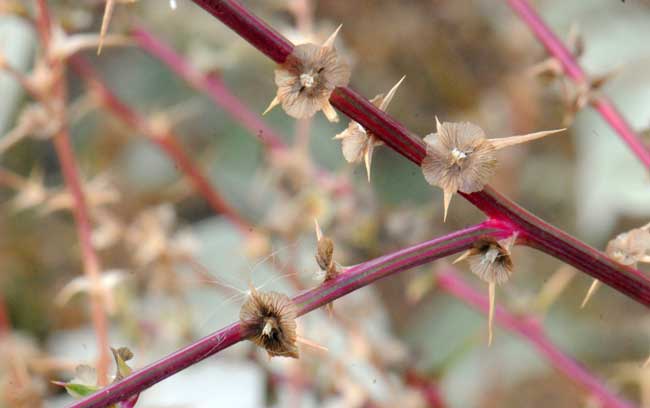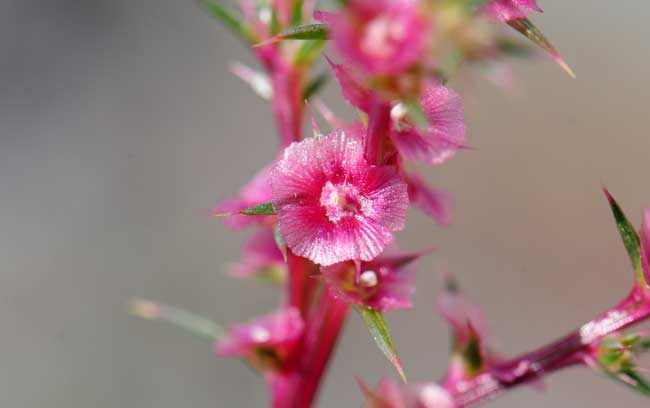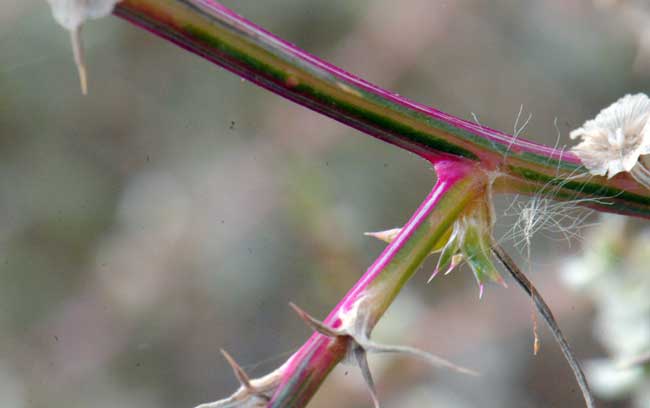Salsola tragus, Prickly Russian Thistle



Scientific Name: Salsola tragus
Common Name: Prickly Russian Thistle
Also Called: Common Saltwort, Common Russian Thistle, Leap The Field, Russian Thistle, Tumbleweed, Tumbling Thistle, Wind Witch, Windwitch (Spanish: Chamizo Volador, Maromero; French: Soude Roulante)
Family: Chenopodiaceae, Goosefoot Family. (Salsola tragus is now included as a sub-family (Salsoloideae) in the Amaranthaceae by some botanists.
Synonyms: (Kali tragus, Salsola australis, Salsola iberica, Salsola kali subsp. ruthenica, Salsola kali subsp. tenuifolia, Salsola kali subsp. tragus, Salsola pestifer, Salsola ruthenica)
Status: Introduced
Duration:Annual
Size: Up to 3 feet, usually smaller.
Growth Form: Forb/herb; stems erect, hispid or glabrous; plants rounded, multiple branches become hard and prickly when dried; stems often red-striped.
Leaves: Green; cauline leaves mostly alternate; leaves filiform or narrowly-linear, leaf tips sharp or spiny.
Flower Color: Inconspicuous, greenish to cream; flowering stalk (inflorescence) spiny; fruiting perianth glabrous.
Flowering Season: July to October.
Elevation: Under 8,000 feet.
Habitat Preferences: Often in dry areas, disturbed areas and cultivated fields.
Recorded Range: Prickly Russian Thistle is widespread throughout the United States, Canada and Mexico.
North America & US County Distribution Map for Salsola tragus.
U.S. Weed Information: The following species of Salsola are listed by 46 state agriculture or natural resource departments; S. tragus, S. iberica and S. kali ssp. tenuifolia: Weeds of Nebraska and the Great Plains, Weeds of the United States and Canada, and Weeds of the West. Plants included here may become weedy or invasive.
Invasive/Noxious Weed Information: The genus Salsola is listed as a Noxious Weed by the state of Arkansas and California and Salsola kali ssp. tenuifolia is listed by the state of Ohio as a "Prohibited noxious weed". Plants included here are invasive or noxious.
Wetland Indicator: In North America Salsola tragus has the following wetland designations: Arid West, FACU; Atlantic and Gulf Coastal Plain, FACU; Eastern Mountains and Piedmont, FACU; Great Plains, FACU; Midwest, FACU; Northcentral & Northeast FACU; Western Mountains, Valleys, and Coast FACU.
FACU = Facultative Upland, usually occur in non-wetlands, but may occur in wetlands.
Threatened/Endangered Information: No data available.
Genus Information: In North America there are 7 species and 7 accepted taxa overall for Salsola. Worldwide, The Plant List includes 174 accepted species names with 78 infraspecific rank for the genus.
In the Southwestern United States, Arizona there are 3 species of Salsola, in California there are 5 species, Nevada has 2 species, New Mexico has 3 species, Texas has 4 species, Utah has 3 species. All data is approximate and subject to taxonomic changes.
Comments: Russian Thistle or Tumbleweed is a typical tumbleweed and the plant breaks free from its base and blows freely in the wind as a "tumbleweed" thus dispersing its seeds. You will often see this weed blowing across roadways or open places and often piling up along fences or other obstacles.
Salsola tragus has been used for a variety of purposes by Western American indigenous peoples.See a complete listing of ethno-botanical uses identified at Native American Ethnobotany, University of Michigan, Dearborn.

